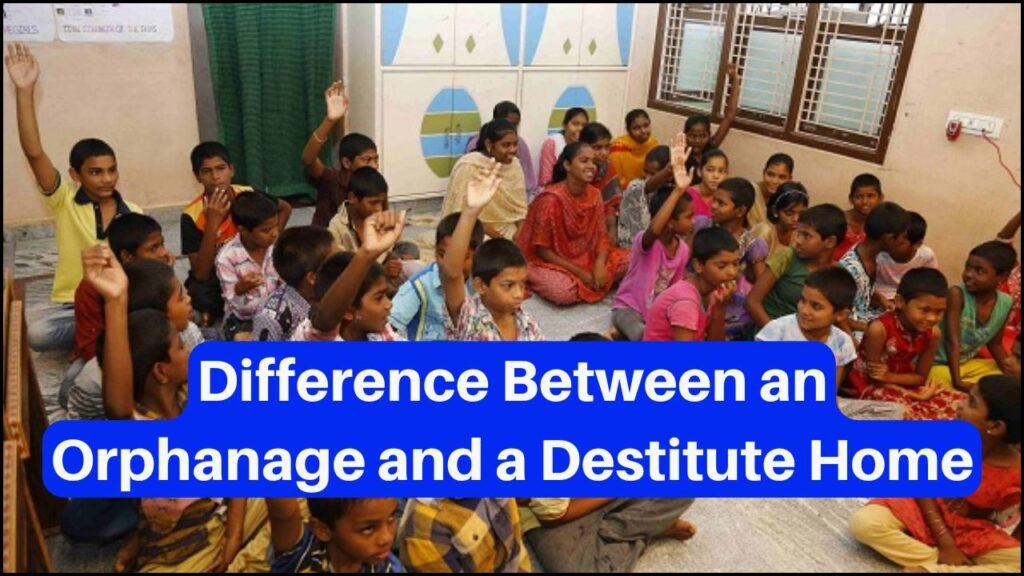
Understanding the difference between an orphanage and a destitute home helps in identifying the specific roles these institutions play in society. Both offer shelter and care to individuals in need, but their purpose, residents, and functioning differ in many ways. An orphanage primarily houses children without parents, while a destitute home accommodates individuals of various ages who are homeless, abandoned, or without support.
Key Features of Orphanages
- Primary Residents
- Children who have lost both parents
- Children abandoned by their families
- Sometimes includes children whose parents cannot care for them due to illness, imprisonment, or poverty
- Age Group
- Usually from infancy to 18 years
- Some institutions allow stay until they become independent
- Purpose
- To offer shelter, food, education, and emotional support
- To ensure proper development and prepare them for a responsible life
- Environment
- Child-friendly setting
- Staff includes caretakers, teachers, counselors, and medical professionals
- Legal Recognition
- Most are registered with child welfare authorities
- Must follow child protection laws
Key Features of Destitute Homes
- Primary Residents
- Homeless adults, including women and the elderly
- People abandoned by their families
- Mentally or physically challenged individuals with no support
- Victims of abuse, domestic violence, or disasters
- Age Group
- No fixed age limit
- Includes individuals from youth to old age
- Purpose
- To provide shelter, food, healthcare, and safety
- To rehabilitate and reintegrate residents into society when possible
- Environment
- More general setup than an orphanage
- Facilities differ based on funding and management
- Legal Recognition
- Some are run by NGOs or the government
- Must comply with human rights and social welfare norms
Comparison: Orphanage vs Destitute Home
| Aspect | Orphanage | Destitute Home |
|---|---|---|
| Definition | Home for parentless or abandoned children | Home for homeless and abandoned people of any age |
| Primary Age Group | Children (0–18 years) | All age groups, mostly adults and the elderly |
| Residents | Orphans, abandoned minors | Homeless, mentally ill, abused women, elderly, destitute |
| Main Services | Shelter, education, healthcare, and emotional care | Shelter, food, medical care, rehabilitation support |
| Legal Requirements | Child Welfare Act, Juvenile Justice laws | Varies by country/state social welfare laws |
| Funding Sources | Government, donations, NGOs | Government, charitable trusts, social organizations |
| Staff Structure | Teachers, wardens, counselors, pediatric doctors | Caregivers, nurses, therapists, and social workers |
| Focus Area | Child growth, safety, and education | Safety, health, dignity, and basic rights |
| Duration of Stay | Until the child becomes an adult or is adopted | Temporary or permanent, based on condition |
| Rehabilitation Options | Adoption, foster care, skill training, education | Counseling, medical help, job training, and family tracing |
Important Points to Note
- Adoption Possibility
- Orphanages often work with adoption agencies
- Destitute homes rarely offer such options due to the resident’s age or condition
- Emotional Needs
- Children in orphanages need emotional bonding and psychological care
- Adults in destitute homes need dignity, empathy, and mental health support
- Government Involvement
- Both types of institutions are monitored, but orphanages often face stricter regulations
- Destitute homes are sometimes overlooked unless supported by NGOs
- Living Conditions
- Orphanages are more structured and educational
- Destitute homes vary greatly in quality, depending on funding
- Public Perception
- Orphanages are viewed as child welfare centers
- Destitute homes are seen as last shelters for the neglected or poor
Real-Life Scenarios
- Orphanage Example
- A child who lost parents in an accident is placed in an orphanage
- The child receives schooling, counseling, and eventually gets adopted
- Destitute Home Example
- An old woman abandoned by her children is taken to a destitute home
- She receives food, medical aid, and lives with others in similar conditions
Services Offered: A Comparison
| Service | Orphanage | Destitute Home |
|---|---|---|
| Food and Nutrition | Regular meals, child-specific diet | Basic meals, sometimes dietary support |
| Health Facilities | Regular check-ups, pediatric care | Emergency and ongoing medical care |
| Education | Formal schooling and extra classes | Basic education or skill training |
| Rehabilitation | Therapy, adoption support | Counseling, job placement |
| Legal Help | Guardianship, adoption process | Legal aid for women, senior citizens |
Emotional and Social Impact
- Children in Orphanages
- Suffer from a lack of family affection
- Show behavioral issues if not properly cared for
- Benefit from stable care and a structured routine
- Individuals in Destitute Homes
- Often suffer from trauma or long-term neglect
- Face challenges in regaining social acceptance
- Require a more inclusive approach to healing
Role of Society and NGOs
- Public Involvement
- Volunteering in orphanages can change a child’s future
- Supporting destitute homes brings dignity to ignored lives
- NGO Role
- Raise funds, recruit professionals, and improve conditions
- Spread awareness about adoption, elder care, and mental health
Suggestions for Improvement
- For Orphanages
- Focus on quality education and emotional bonding
- Encourage foster parenting and regular audits
- For Destitute Homes
- Provide legal identity documents and rehabilitation training
- Promote community participation and government grants
Final Thoughts
A clear difference exists between an orphanage and a destitute home in terms of residents, services, and goals. Orphanages cater mainly to children without families, while destitute homes support people of all ages who lack shelter or care. Both play a vital role in humanitarian efforts and require support from the public, government, and NGOs. Better awareness and proper resources can improve the lives of those living in such homes and help them lead a life of dignity and hope.









